Efficient direction-independent fog harvesting using a corona discharge device with a multi-electrode structure
Dingchen LI (李丁晨), Chuan LI (李傳),* , Jiawei LI (李家瑋),Wendi YANG (楊文迪), Menghan XIAO (肖夢涵), Ming ZHANG (張明),Yong YANG (楊勇) and Kexun YU (于克訓)
1 International Joint Research Laboratory of Magnetic Confinement Fusion and Plasma Physics, State Key Laboratory of Advanced Electromagnetic Engineering and Technology,School of Electrical Engineering and Electronics, Huazhong University of Science and Technology, Wuhan 430074, People’s Republic of China
2 State Key Laboratory of Advanced Electromagnetic Engineering and Technology, School of Electrical Engineering and Electronics, Huazhong University of Science and Technology, Wuhan 430074, People’s Republic of China
Abstract Efficient collection of water from fog can effectively alleviate the problem of water shortages in foggy but water-scarce areas, such as deserts, islands and so on. Unlike inefficient fog meshes,corona discharge can charge water droplets and further enhance the water-collecting effect.This study proposes a novel multi-electrode collecting structure that can achieve efficient and direction-independent water collection from fog. The multi-electrode structure consists of three parts:a charging electrode,an intercepting electrode and a ground electrode.Four types of watercollecting structures are compared experimentally,and the collection rates from a traditional fog mesh, a wire-mesh electrode with fog coming from a high-voltage electrode, a wire-mesh electrode with fog coming from a ground electrode and a multi-electrode structure are 2-3 g h-1,100-120 g h-1, 60-80 g h-1 and 200-220 g h-1, respectively. The collection rate of the multielectrode structure is 100-150 times that of a traditional fog mesh and 2-4 times that of a wiremesh electrode. These results demonstrate the superiority of the multi-electrode structure in fog collection.In addition,the motion equation of charged droplets in an electric field is also derived,and the optimization strategy of electrode spacing is also discussed.This structure can be applied not only to fog collection, but also to air purification, factory waste gas treatment and other fields.
Keywords: fog collection, corona discharge, wire-mesh electrode, multi-electrode structure,collection rate
1. Introduction
The freshwater resources on Earth only account for about 2%of the total amount of water, and the total amount of fresh water that can be used by humans only accounts for 3‰ [1].The shortage of freshwater resources heavily restricts human life, economy and industrial development [2]. Approaches to obtain fresh water,such as desalination by distillation,reverse osmosis membrane and electrodialysis, can alleviate this problem, but the poor economy and geographic dependence limit its popularization [3, 4]. Atmospheric water is a widely distributed freshwater resource [5]. Its collection has littleimpact on the environment, and the collected water is clean and can be used directly [6]. Therefore, the collection of atmospheric water resources is expected to alleviate the shortage of freshwater resources in water-scarce areas.

Table 1. Brief summary and comparison of the various methods used to collect water from air.
Clouds, fog and water vapor are the main three existing forms of atmospheric water resources in the air[7].Compared with clouds and water vapor, fog is closer to the ground and has a larger particle size (1-30 μm), which is beneficial for collection [5, 7, 8]. Therefore, efficient fog collection has always been a research hotspot in the field of environmental protection and sustainable development.So far,typical manual methods of collecting fog are bionic collection, fog nets and a metal organic framework (MOF). The summarized characteristics of the various methods to collect water from air are shown in table 1.They include methods to collecting fog from various aspects, including bionics, physics and molecular structure. However, they have special requirements regarding humidity, location, materials and so on. Cost and collection efficiency have also affected large-scale applications.
Inspired by electrostatic precipitators, corona discharge has been applied to the fog collection [23]. Corona discharge can generate gaseous ions to charge droplets, which can further be easily collected by a ground electrode under an electric field[23-25].Similar to electrostatic precipitators,the main factors affecting the collection rate include the charge rate of droplets, the collection area of the ground electrode and the speed of the fog droplets [26-29]. According to the theories on electrostatic collection of droplets [30], charged particles and electric fields can increase the collision crosssection of droplets on the ground electrode. The positive role of a large collection area has been demonstrated by the efficient collection of fog under a multilayer ground electrode [31].
As for the moving speed of fog droplets, it mainly depends on the distribution of the electric and flow fields,which are closely related to the electrode structure [32].Hence, electrode optimization becomes a significant and effective means to improve the droplet collection rate. However, there are few studies on the optimization of electrodes for the electrostatic collection of fog droplets. Therefore,electrostatic precipitators, which also collect particles, can give us some inspiration. Yamamoto et al improved the traditional wire-plate electrode structure to enhance particle collection by using a ground electrode plate with a collection bag [33, 34]. Dau et al improved the needle-plate electrode structure with a bipolar double needle structure,which greatly increases the collection rate [27]. Gao et al compared the collection rates of four high-voltage electrodes with three ground electrodes by numerical simulation[29].These results indicate that electrode structure can change the distribution of electric and flow fields, thereby causing a change in the collection efficiency.
Thus, a novel multi-electrode structure is proposed here to enhance the droplet collection rate.The multi-electrode structure includes a charging electrode, a ground electrode and an intercepting electrode. These three electrodes divide the electrode region into a charging region and an intercepting region. The basic principle is that fog droplets are fully charged in the charging region,and subsequently repeatedly collected by the ground electrode under the turbulence generated in the intercepting region. The multi-electrode structure not only can effectively enhance the collection rate of droplets, but also can collect droplets regardless of fog direction after further optimization. The motion equation of charged droplets in the electric field is analysed to guide the design of the multi-electrode structure. In addition, the collection rate and power consumption of a wiremesh electrode and a multi-electrode structure under various electrode spacings and voltages are also discussed.
2. Theoretical analysis
Fog collecting efficiency is mainly affected by the movement process of droplets, so it is necessary to study the force equations of fog droplets during the collecting process.Considering actual situations, the following assumptions are adopted in this work [8]:
(1) Fog droplet shape is spherical.
(2) After fog droplets are fully charged, the amount of charge remains unchanged.
(3) The interaction between droplets is ignored.
(4) The effect of gravity is ignored.
(5) Background gas is still air.
2.1. Charge of fog droplets
There are two types of droplet-charging mechanisms, fieldinduced charging and diffusion charging [30, 35, 36], and both are related to the droplet size. Field-induced charging dominates when the droplet radius dp>0.5 μm, and diffusion charging dominates when the radius dp<0.2 μm[8,31].Generally, in nature, the fog droplet size ranges from 4 to 30 μm [8, 37, 38]. The droplet sizes used in this study ranged from 1 to 15 μm, and the particle size spectrum is shown in figure 8(a). Therefore, the dominant charging method of droplets is field-induced charging. The charge model of the droplet caused by the field charge is [30]
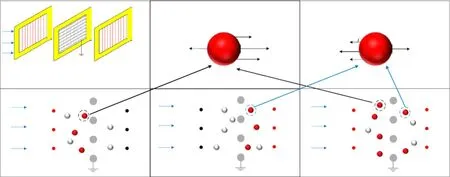
Figure 1. Force diagram of fog droplet under different conditions. (a) The multi-electrode structure. (b) and (c) The force diagram of fog droplets in different regions. (d) Wire-mesh electrode with fog droplets coming from high-voltage electrode (FH condition). (e) Wire-mesh electrode with fog droplets coming from ground electrode (FG condition). (f) Multi-electrode with fog droplets coming from outside. Red ball and silver ball represent charged droplet and neutral droplet, respectively.

where, ε is relative permittivity, ε0is dielectric constant of vacuum,E0is electric field strength in the ion transport region,dpis droplet diameter and t0is a time constant related to ion concentration,electronic charge and ion mobility.It is generally believed that when charging time t=10t0, the droplet charge reaches a saturation value. The droplet’s saturation charge is

2.2. Force of the droplet
Figure 1 shows the force states of fog droplets under various working conditions. The main forces include
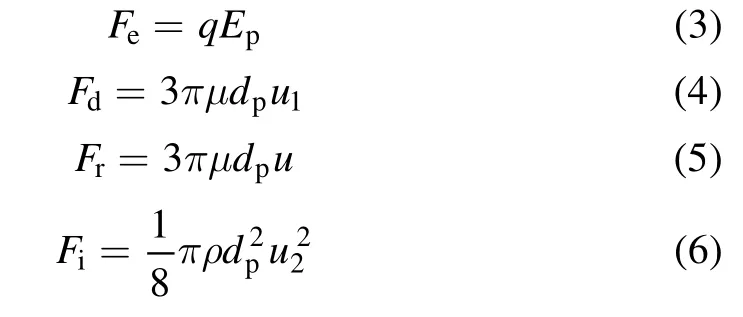
where,Feis electric field force,Fdis the drag force of incoming flow,Fris the air resistance of a droplet,Fiis the drag force of ion wind[39],q is amount of droplet charge,Epis the collecting electric field strength,μ is aerodynamic viscosity, dpis droplet size, u1is incoming wind speed, u is fog droplet velocity, ρ is the density of air and u2is the speed of the ion wind.
According to the force analysis of droplets in figures 1(b)and(c),it is easy to obtain the motion equation of charged fog droplets in an electric field:

where m is the mass of a fog droplet.
In the wire-mesh electrode, when fog droplets enter the electric field from the high-voltage electrode,the electric field force of fog droplets has the same direction as drag force, as shown in figure 1(b). Therefore, the droplets cannot be decelerated in the electric field. When the droplets enter the electric field from the ground electrode,the electric field force of droplets is in the opposite direction from the drag force,as shown in figure 1(c). The fog droplets may decelerate, even retrace. When fog droplet velocity u reduces to zero, the fog droplet reaches the farthest position, and the decelerating distance of the fog droplet passing through the ground electrode is defined as intercepting distance L.
In order to simplify the calculation of L, the amount of charge when the droplet enters the electric field is considered to be saturated. Substituting equation (3) to equation (6) into equation (7), and integrating them, the velocity equation of fog droplets in the electric field can be obtained:

The moment when the fog droplet passes the ground electrode is defined as t=0. By further integrating the fog droplet velocity u, the intercepting distance in which the droplets decelerate in the electric field can be obtained.It can be used to estimate the spacing of the interception region of multi-electrode structure.


Figure 2. Schematic diagram of the experimental setup. According to the fog direction, the electrode order can be wire-mesh or multielectrode. The high-voltage electrodes are made of wires and the ground electrode is made of a stainless steel metal mesh.

Table 2.Summary of the working conditions of the wire-mesh electrodes and the multi-electrode setup. The working conditions of multielectrode collection of droplets have various intercepting voltages and intercepting electrode spacings.
3. Experiment and discussion
3.1. Experimental equipment and working conditions
As shown in figure 2, the experimental device consists of an insulated frame, an insulator and an electrode. There are two high-voltage electrodes on both sides and a ground electrode in the middle. As the high-voltage electrode, the wire electrode is made of 0.05 mm stainless steel wire with wire spacing of 4 cm.The ground electrode is made of a stainless steel metal mesh, and has the same mesh size as a traditional fog mesh for fog-collection rate comparison. The size of the electrode frame is 25 cm×25 cm, and the effective collection area of the electrode is 20 cm×20 cm.In order to make the droplets coagulated on the electrode fall off as much as possible to prevent blocking the mesh and affecting collection, there is superhydrophobic coating on the ground electrode. All electrodes are fixed on the insulation frame by using four insulators,and the high-voltage electrodes on both sides can move by the sliding slot. The ultrasonic humidifier(HQ-JS130H, HaoQi) is used to generate fog droplets. A beaker,an electronic balance,a particle diameter spectrometer(PW180-8,Shandong NKT)and a microammeter are adopted to measure the collection rate,fog droplet particle size and the current through the ground electrode under various working conditions. The working conditions of the experimental device are summarized in table 2. When the working condition is FH or FG, the arrangement of electrodes is shown in figure 3. The electrodes used in both cases are wire-mesh electrodes.The difference is that in the FH condition,the fog enters the electric field from the wire electrode (high-voltage electrode), while in the FG condition, the fog-charging mesh electrode (ground electrode) enters the electric field. When the working condition is multi-electrode, the electrode equipment is shown in figure 4, and the electrodes are wiremesh-wire electrodes. The two wire electrodes are, respectively, a charging electrode and an intercepting electrode,both of which are connected to a negative high-voltage power supply. Between the two electrodes is the mesh electrode(ground electrode). The fog enters the electric field from the charged electrode.
3.2. Collection rate of wire-mesh electrodes
Figure 5 shows the relationship between the droplet collection rate and voltage of the wire-mesh electrode under FH working conditions. Obviously, before the voltage reaches the corona initiation voltage, the ground electrode mesh acts as an ordinary fog mesh to collect the droplets, and the collection rate is only 2-4 g h-1. In this case, the droplets are collected only by the collision between the droplets and the mesh, and the efficiency is extremely low,as shown in figure 3(II).After corona discharge activates, the collection rate increases significantly with the voltage. This is because corona discharge can charge the fog droplets and drive them to the ground electrode under the action of the electric field.In other words,the charges carried by droplets and the electric field increase the collection area of the mesh, as shown in figure 3(III). In addition, the charged droplets can form an electric field with the ground electrode, which is superimposed on the electric field of the corona discharge, which further strengthens the ability of the mesh wires to capture droplets [40]. This result indicates that corona discharge plays a positive role in improving the collection rate of fog droplets.
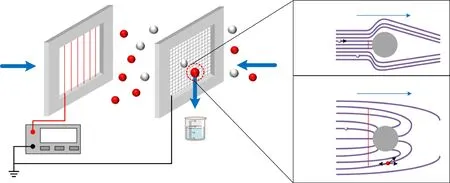
Figure 3.I is a schematic diagram of the experimental device for collecting fog with a wire-mesh electrode.II and III are schematic diagrams of the force without and with the fog droplets charged [30]. (a) and (b) represent the fogging directions of the wire-mesh electrode under different working conditions,(a)represents that the fog enters the electric field from the high-voltage electrode(FH),(b)represents that the fog enters the electric field from the ground electrode (FG). The red and silver balls represent charged droplets and neutral droplets,respectively. Purple lines represent the trajectory of the droplet.

Figure 4. Schematic diagram of the experimental device for collecting fog with a multi-electrode device. Red and silver balls represent charged droplets and neutral droplets, respectively. The velocity of the charged droplets after being accelerated by the electric field is 2.075-3.15 m s-1.
As the voltage increases,the collection rate appears to be saturated, which is consistent with the results of previous studies [30]. The saturated collection rate is 80-140 g h-1,which is 40-70 times the fog mesh collection rate.The reason for the saturation value of the collection rate may be that electric field force Fe, drag force of incoming flow Fdand drag force of ion wind Fican accelerate fog droplets, but air resistance of droplet Fralso increases with the speed.Finally,the balance of the four forces has led to no further increase in the collection rate [30]. In addition, the larger the electrode spacing,the higher the voltage required for the collection rate to reach the saturation value. Note that the experimental cutoff voltages under various electrode spacing are derived from the experimental breakdown voltage or maximum output voltage of power supply.

Figure 5. Collection rate of wire-mesh electrodes with various electrode spacings under the FH condition.
Although the wire-mesh electrode can increase the collection rate of the fog mesh under the FH condition, the fog can only pass through the mesh once.This means that the fog mesh can only collect fog droplets once,and there will still be a large number of fog droplets passing through the fog mesh.According to previous research, we know that the factors affecting the collection rate of droplets are not only the charge rate, but also the collection area and the driving speed[28,31,41].Flow field and electric field are the main factors that affect the above two factors. Thus, inspired by the electrostatic precipitator, the number of times that fog passes through the ground electrode can be improved by turbulence,so as to increase the collection area [27, 41]. Therefore, a scheme of collecting fog droplets using a wire-mesh electrode under the FG condition is proposed [42].
The results for the collection rate of a wire-mesh electrode under the FG working condition are shown in figure 6.Similar to FH, when the voltage does not reach the corona initiation voltage, only the ground electrode mesh is used to collect the droplets, and the collection rate is low. However,after the applied voltage reaches the corona initiation voltage,the collection rate first increases and then decreases with the applied voltage. The peak value is 60-80 g h-1, which is 20-40 times the collection rate of ordinary fog mesh, but is lower than FH. This phenomenon can be explained by number of times the droplets pass through the mesh and the charges carried by droplets. When the fog droplet passes through the mesh,it is collected by the ground electrode once,and this case is regarded as fog mesh collection. Then, the droplets are charged in the region with a high electric field.Under the action of flow field and electric field, charged droplets return to the ground electrode again to achieve secondary collection,which can be seen in the droplet trajectory shown in figure 7(b)at 20 kV.Thus,the turbulence caused by corona discharge does increase the number of times the droplets are collected. However, due to the low concentration of charged particles near the ground electrode, the charges carried by fog droplets are insufficient.Therefore,the maximum collection rate of FG is lower than that of FH.

Figure 6.Collection rate of a wire-mesh electrode with various electrode spacings under the FG condition.
In addition, the collection rate peak is the balance result of fog speed and reverse motion caused by ionic wind and electric field. For low voltage, the droplets can enter the electric field and return to the ground electrode under the weak action of electric field force and ion wind to complete the collection of droplets, as shown in figure 7(b) at 20 kV.For high voltage, the strong ion wind prevents the droplets from reaching the ground electrode, resulting in a rapid decrease in the collection rate, as shown in figure 7(b) at 25 kV. Note that the fog and ionic wind are in the same direction for FH as shown in figure 7(a), thus there is no obvious peak in figure 5.
3.3. Collection rate of the multi-electrode structure
From the above results, it can be seen that the wire-mesh electrode can fully charge the droplets under the FH condition, but it can only be collected once. Under the FG condition,although the wire-mesh electrode can collect the droplets multiple times, the charge rate of the droplets is low. Therefore, a scheme of collecting fog droplets with a multi-electrode structure is proposed, as shown in figure 4. The multielectrode structure includes a charging electrode, an intercepting electrode and a ground electrode.The three electrodes divide the space into two regions: a charging region and an intercepting region. The charging region can ensure the high charging rate of fog droplets, and the intercepting region can generate turbulence, which makes the first uncollected droplets return to the ground electrode to realize the second collection.
The electrode spacing of the charging region can be set according to the previous experimental results. In order to reduce power consumption and insulation requirements, the electrode spacing of the charging region can be set to 4 cm.It can be seen from figure 5 that when the voltage is 14 kV,the FH collection rate of the wire-mesh electrode reaches saturation. Therefore, the voltage of the charging electrode can be set to 14 kV.For the intercepting region,the electrode spacing can be determined based on the calculation result of equation(11).As shown in figure 8,the particle size range of the fog droplets generated by the ultrasonic humidifier is 1-15 μm.The droplets with various charge rates move in the electric field for a distance of 0.5-1.5 cm in this size range.When setting the electrode spacing, a certain margin is considered to ensure the effective interception of droplets.Therefore, the electrode spacing in the intercepting region should be no less than 4 cm.

Figure 7.Droplet trajectory under different working conditions when the wire-mesh electrode spacing is 8 cm. (a) FH, (b) FG.
Figure 9 shows the droplet collection rate of the multielectrode structure under different intercepting region spacings when the charging region spacing is 4 cm and the charging voltage is 14 kV.Similar to the FG condition of the wire-mesh electrode,there is a peak in the collection rate.The maximum collection rate is 210-225 g h-1, which is 2-4 times that of the wire-mesh electrode. However, at the initial stage of voltage applied in the intercepting region, the collection rate is 75-110 g h-1. The main reason for this phenomenon is that the intercepting region in this case has no obvious intercepting effect on the droplets, and this case is equivalent to the FH working condition of the wire-mesh electrode.As the intercepting voltage increases,the collection rate first increases and then decreases. This trend can be explained by that when the intercepting voltage is low, the intercepting region can return the droplets that were not collected by the ground electrode for the first time to the ground electrode to form a secondary collection.In addition,after the droplets enter the interception region, since the intercepting electrode can also generate gas ions in the ionization region,the droplets that are not sufficiently charged in the charging region can supplement the charge in the interception region.However, when the intercepting voltage is high enough, the intensity of ion wind generated in the intercepting region gradually increases,and the droplets cannot reach the ground electrode, resulting in a rapid drop in collection rate.

Figure 8.Estimation of droplet deceleration distance.(a)The volume ratio of droplet size distribution produced by the ultrasonic humidifier,(b)the deceleration distance of the charged droplet in the electric field.
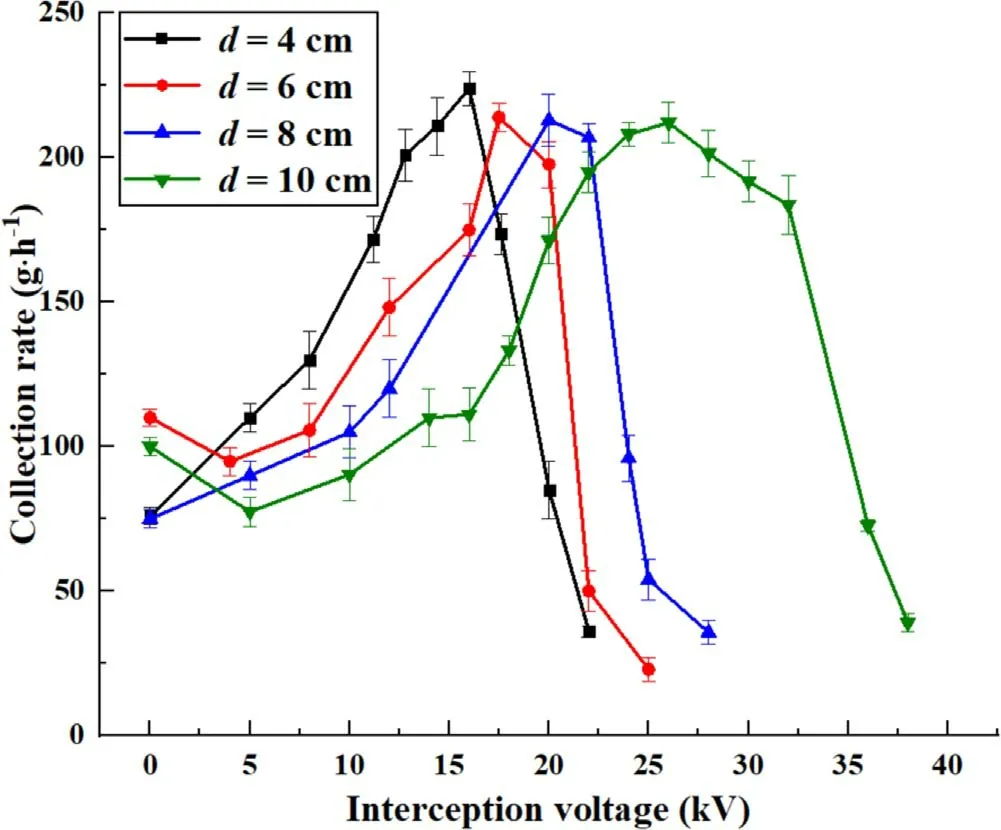
Figure 9.Collection rate of the multi-electrode structure with various electrode spacings and intercepting voltages.

Figure 10.Comparison of the maximum collection rate of different electrode structures. (represents the ordinary fog mesh,represents the wire-mesh electrode under FH,represents the wire-mesh electrode under FG, andrepresents the multielectrode structure).
In addition, the maximum collection rate of various electrode structures and the corresponding power consumption are compared. As shown in figure 10, the droplet collection rates of the fog mesh, FH, FG and multi-electrode structures are 2-3 g h-1, 80-140 g h-1, 60-80 g h-1and 210-220 g h-1, respectively. Obviously, corona discharge strengthens the fog mesh’s ability to collect droplets, and the multi-electrode structure increases the collecting times of the fog mesh,resulting in a huge increase in its collection area.It can be seen in figure 11 that the power consumption increases with electrode spacing, regardless of electrode structure. The power consumption of the electrode under the three working conditions are 0.67-1.67 W, 0.22-0.43 W and 1.67-2.5 W,respectively. They are economical and efficient, compared with desalination by distillation, and electrodialysis. The power consumption of the multi-electrode structure is significantly higher than those of the others, because both the charging region and the intercepting region consume electric energy.Figure 11 also shows the ratio of power to maximum collection rate. This ratio characterizes the electrical energy consumed per unit collection rate.The ratios in the three cases are 0.0057-0.019, 0.0036-0.0058 and 0.00745-0.0118,respectively. Although the power required per unit collection rate for the multi-electrode structure is the highest,it is only in the order of 10-3. Considering the collection rate and power consumption comprehensively, the optimal electrode spacing in the intercepting region can be set as 4 cm.

Figure 11.Power consumption for maximum collection efficiency and the ratio of power to maximum collection rate in the three cases.P/C represents the ratio of power to maximum collection rate.
For the spacing of the charged region, the discharge characteristics and the collection rate need to be comprehensively considered. In addition to the influence of the electrode structure, the corona discharge is also affected by the droplets. After the droplet enters the electric field, it affects the discharge in three aspects: ion mobility, electric field and current.
For the ion mobility, droplets enter the electric field region and change the gas environment (gas density and relative humidity) around the electrodes. According to previous studies, the ion mobility can be expressed as:

where, K is the ion mobility,λˉ is the mean free path of the ion,vˉ is the average velocity of thermal motion, and moand M are the masses of ions and gas molecules,respectively.The ionic mobility of the fog environment is as follows [40]:

where, mais the dry air density and mhis the water vapor content of the air at a relative humidity of 100%; Mais the relative molecular mass of air.Under normal temperature and pressure, the air density is 1.2 kg m-3. When the fog enters the electric field, the water vapor content is about 20 g m-3.Therefore, bringing in equations(13)and(14),it can be seen that the ion mobility is slightly reduced.Specifically,it can be obtained that the ion mobility after fogging is about 98% of that in a dry environment.The reason for this phenomenon is that hydrated ions are generated by corona discharge in a foggy environment [43].
For the electric field strength, the droplets entering into the electrode area will affect the roughness coefficient of electrode surface,according to Peek’s empirical formula[40]:

where, r is the radius of wire electrode and m is the surface roughness factor.In a dry environment,m is generally 0.5.In foggy environment, the value of m is generally taken as 0.44[40]. The droplets therefore reduce the onset electric field strength of the electrodes. After the fog is cleared, the onset field strength is about 0.88 times that of the dry environment.The corona inception electric field is reduced, which makes the electrode spacing too small to be more prone to breakdown. In addition, an electric field is formed between the charged droplets and the ground electrode, which superimposes in the same direction the electric field generated by the corona discharge to form a synthetic electric field. The smaller the electrode spacing, the greater the effect of the synthetic electric field on the discharge, which makes the electrodes more susceptible to breakdown. For discharge current,it is closely related to ion mobility[44].According to equations (13) and (14), the ion mobility in the fog environment is slightly reduced. Therefore, its discharge current will also decrease. However, in a dense fog environment,the ion mobility is only reduced by 2%,so the effect of fog droplets on the current is not significant. Comprehensively considering the collection rate, power consumption,compactness of device and so on, the optimal electrode spacing in the intercepting region is set as 4 cm.
Since the intercepting region and the charging region have the same electrode spacing (4 cm here), the multi-electrode structure can freely adjust the voltage switching direction of the two regions. Therefore, from this perspective, the multi-electrode structure can also collect fog droplets regardless of fog direction.
In summary, when fog is collected using a multi-electrode structure, the fog intercepting the voltage near the ground electrode by adjusting the voltage of the intercepting electrode achieves the highest collection rate.
4. Conclusion
A novel multi-electrode structure with a charging region and an intercepting region is put forward in this paper to improve the collection rate of fog droplets. In this paper, the force equation and the intercepting distance equation of a charged fog droplet in an electric field are given, which provides guidance for the design of electrodes. Then, the collection rates of a wire-mesh electrode under different working conditions and a multi-electrode structure are compared, and the maximum collection rate and power consumption in the above cases are discussed. Finally, according to the theoretical calculation and experimental results, the optimal multielectrode structure is proposed. The innovative electrode structure shows the advantages of high efficiency and independent fog direction. The specific conclusions are as follows:
(1) The maximum fog droplet collection rate of the wiremesh electrode under the FH condition is 80-140 g h-1.Although it can fully charge fog droplets, the ground electrode can only collect fog droplets once.
(2) The maximum fog droplet collection rate of the wiremesh electrode under the FG condition is 60-80 g h-1.This condition produces turbulence and enables multiple collection of fog droplets. However, due to the low concentration of charged particles near the ground electrode, the charge rate of fog droplets is also low.
(3) For the multi-electrode structure, the maximum collection rate can reach 210-220 g h-1, which is 100-150 times that of the fog mesh and 2-4 times that of the wire-mesh electrode.
(4) The motion distance equation of charged fog droplets in an electric field can be used to guide the design of multi-electrode structures and to ensure low power consumption and efficient collection of fog droplets.
(5) The design principles of the multi-electrode structure are that the charging region ensures full charge of the droplets and the intercepting region effectively intercepts uncollected droplets.
In future work, some issues need to be studied, such as the choice of electrode material, electrode size, the arrangement of multilayer ground electrodes and the flow field distribution of the multi-electrode structure.
Acknowledgments
This work is supported by the National Key Research and Development Program of China(Nos.2016YFC0401002 and 2016YFC0401006),and National Natural Science Foundation of China (Nos. 51577080 and 51821005).
ORCID iDs
Chuan LI (李傳) https://orcid.org/0000-0003-4761-5160
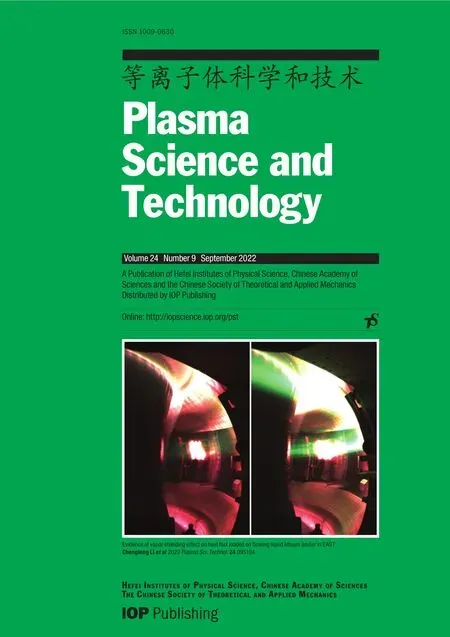 Plasma Science and Technology2022年9期
Plasma Science and Technology2022年9期
- Plasma Science and Technology的其它文章
- Degradation of tiamulin by a packed bed dielectric barrier plasma combined with TiO2 catalyst
- Development of a compact high-density blue core helicon plasma device under 2000 G magnetic field of ring permanent magnets
- Improvement of the spreading effect of atmospheric pressure microplasma jet treatment through shielding-gas-controlled focusing
- Experimental study on surface arc plasma actuation-based hypersonic boundary layer transition flow control
- Microchannel cooling technique for dissipating high heat flux on W/Cu flat-type mock-up for EAST divertor
- Implementation and application of PyNE sub-voxel R2S for shutdown dose rate analysis
